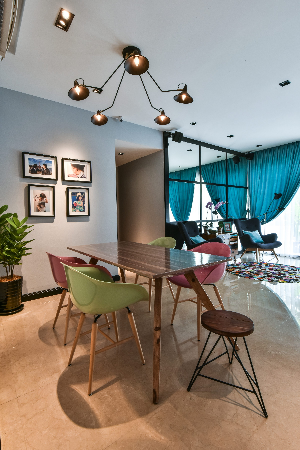The dining table is most often the central feature of dining spaces, contributing the most towards the décor by virtue of their size - which makes their selection all the more crucial.
The dining room is probably the one part of a home that sees the most people at any time - and whether people are just passing through or sitting down for meals, the table will have an impact on how diners perceive the space, the home, and the homeowner. As the selection of dining room furniture will likely be an event that does not occur very often, we wanted you to be as informed as possible before you set out on your journey towards your new dining table.
Material
 Interior design by: Viincology
Interior design by: Viincology
The kind of material that your dining table is made out of will have an effect on its lifespan and its appearance. Long-lasting materials such as hardwoods, metals, tempered glass, stone, and even mould-injected plastics are preferred for dining tables that are expected to endure many years of heavy use. Conversely, lightweight or flat-pack furniture composed of veneered wood composites such as plywood or fibreboard are made with mobility and affordability in mind, these materials are preferred for short-term arrangements by virtue of their being easier to pack and transport by design.
 Interior design by: Viincology
Interior design by: Viincology
Lightweight composite materials such as plywood or fibreboard are known to be significantly less durable, as they show a tendency to warp when subjected to excessive moisture or heat. Tougher natural materials such as hardwoods and stone tend to be porous, which entail regular maintenance with coats of varnish or sealer to prevent unintended staining from everyday use.
 Interior design by: SNG Conceptwerke
Interior design by: SNG Conceptwerke
Due to their being porous and softer than metal, wooden surfaces entail a greater degree of care to ensure their longevity. Oil-based varnishes should be applied to wooden surfaces at the point of manufacture - and periodically afterwards to prevent unintentional staining. Despite the higher level of maintenance required, metal furnishings tend to rust - especially when used outdoors, while wooden furnishings take on a characteristic smoothness and polished sheen as they age.
Size
 Interior design by: Hoe & Yin Design Studio
Interior design by: Hoe & Yin Design Studio
Having too large a table surface will result in a cramped dining space, while restricting diners to a small surface leads to elbows bumping in uncomfortably close quarters. It is the recommendation of most decorators to provide each diner with around 60 to 70 centimetres (or 24 to 28 inches) of space for adequate elbow room, and around 90 centimetres to 1.3 meters (or 36 to 50 inches) between a dining table and the surrounding walls for diners to comfortably get in and out of their seats.
Shape
 Interior design by: IDS Interior Design
Interior design by: IDS Interior Design
The shape of your dining table will determine the number of diners you can host and will affect the space it occupies. While round tables are capable of accommodating a greater number of diners, they tend to appear larger in small dining spaces - the conventional rectangular dining table takes up the most space, needing long and narrow spaces to avoid appearing overly large.
 Interior design by: IDS Interior Design
Interior design by: IDS Interior Design
To calculate the number of diners appropriate for a round table: multiply the diameter of a table by the value of Pi (π: 3.14) and divide the result by the amount of space needed for each diner. Using the previously mentioned minimum of 60 centimetres (or 24 inches) of space needed per diner, a round table with a diameter of 1.5 meters can easily accommodate 7 diners, or up to 8 diners with a negligible reduction in elbow room - while a rectangular table of similar size (at 1.5 meters long) can only seat a total of 6 diners – one at each end and two along each length.







Leave your comment